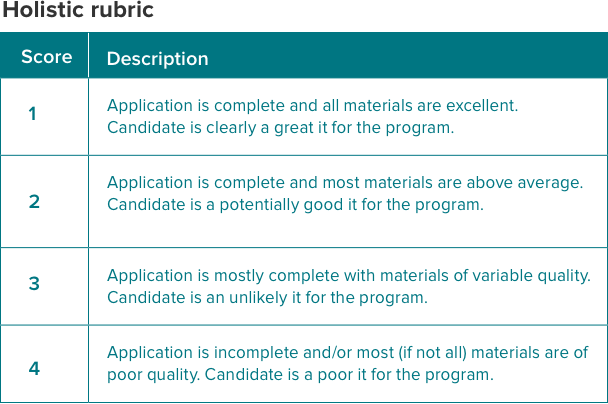
Your institution’s programs are one of a kind—and offering scholarships and fellowships can help you share these assets with a wider community. As you design applications and set up review, remember that the first step in any smart process is the creation of a thorough rubric. Rubrics are detailed outlines for how each application will be read and scored. Using rubrics to review scholarship and fellowship applications helps reviewers stay consistent, minimizes personal bias, and provides a useful reference for everyone involved in the process.
Most commonly created by teachers to assess student performance, rubrics are useful for evaluation processes of all kinds. If you create a rubric before building your application, it can help ensure all requested information is relevant and necessary. This saves time for applicants as well as your team.
According to Brown University’s Harriet W. Sheridan Center for Teaching and Learning, there are a series of vital considerations for creating a successful review system. Here are six steps they identified, refocused for using rubrics to review scholarship and fellowship applications:
Consider the components of your application and how each should be assessed. What would an outstanding application include? How detailed do you want to be with scoring? Should each application component receive a distinct score?
In terms of basic distinctions, the holistic rubric is easier to put together but offers less detail than an analytic rubric regarding specific strengths and weaknesses within an application. For example, a holistic rubric might ask reviewers to assign a score of 1-4 for the application as a whole (where a Level 1 application includes a high GPA, excellent references, and an outstanding essay). An analytic rubric would assess the GPA, references, and essay using distinct scales and criteria.


These criteria identify each component for assessment. For fellowships and scholarships, common review criteria include:
Although this could include letter grades, for application review, numeric scores are likely to be the most useful. Most scales include 3-5 rating levels.
Clarity and consistency of language here will help accurately guide reviewers. Focus on observations that can be accurately measured and include the degree to which criteria are successfully met.
Format your rubric for easy access and reference, assess effectiveness, collect relevant feedback, and revise accordingly. Using rubrics to review scholarship and fellowship applications should involve ongoing updates to your system—a rubric is only as effective as it is relevant to current goals.
A strong rubric not only helps guide reviewers—it also offers the opportunity to deeply assess and streamline your application. If part of your application didn’t make the rubric, do you really need it to review your candidates?
A few additional rubric strategies to employ:
Anyone who takes the time to apply for your scholarship or fellowship wants to submit the best possible application. Unfortunately, every application process is different and prospective applicants may not know what your organization is looking for. Sharing clear information about your assessment criteria and timeline is a huge help—and rubrics are a great way to do this.
While you don’t have to show the point system or all of your evaluation guidelines, sharing the main criteria for a successful application established in the rubric benefits everyone involved in your process:
Being more transparent about your process by sharing the criteria in your rubric sets you apart from other institutions, facilitates trust from potential applicants, and brings clarity to the whole process. Just be sure what you share is easy to access and written in a simple, jargon-free format.
Submittable’s custom review forms are perfect for incorporating your rubric. Looking for scholarship management software or fellowship management software? Submittable is here to help. For more tips on a fair and efficient scholarship and fellowship review process, check out this guide.